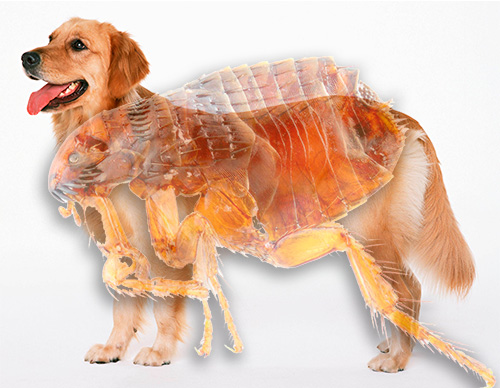
Among the variety of different types of fleas, a dog flea is one of the most common. However, fleas in dogs are not only insects belonging to the type of dog flea Ctenocephalides canis.
In reality, small bloodsuckers running around and jumping on a dog can belong to very different species - human fleas, cat, rat, etc. willingly eats blood of the four-footed friend. All these types of parasites are difficult to distinguish from each other without a microscope and special skills, therefore, understanding the general issues of dealing with fleas, dog owners usually call them all just dog fleas.

That same dog fleas, as a separate species, a little less common than the cat. They have a smaller range of possible hosts, they do not reproduce so quickly, but at the same time they quite successfully infect all “come across” dogs.In general, they disturb a person at about the same frequency as feline parasites.
The appearance of dog fleas: adult insects, larvae and eggs
Dog fleas look the same as most of their relatives: small insects 2-3 mm in length dark brown with a shiny little body. On an enlarged photo of a dog flea, the body of the insect is oblong and flattened from the sides:

And in the photo of a dog flea under a microscope, the exorbitantly elongated hind paws of the insect first of all rush to the eyes. They allow parasites to jump a distance of 100-150 times the length of their body:
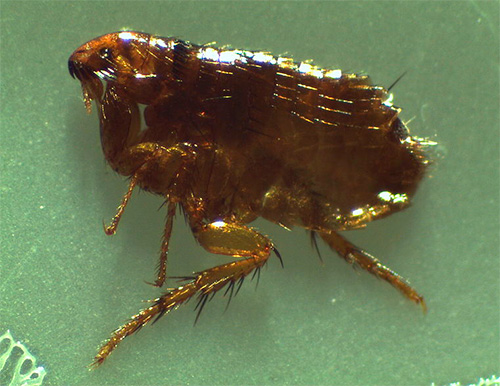
Even with the naked eye one can see that these insects do not have wings. This is an important evolutionary adaptation, ensuring the ease of movement of parasites in the coat and minimal risk for the flea to be caught and crushed.
Fleas in dogs and cats almost when choosing a food source are very similar to each other: just as cat pests easily jump over dogs, so dog parasites are not averse to feeding on cats. However, in general, cat fleas are more numerous, and even on dogs are found somewhat more often than the dog itself.
It is interesting
Externally, dog and cat fleas are well distinguishable only under a microscope. The dog parasites have a slightly more rounded and dull head, and on the hind legs have eight setae instead of six, like those of the cat.
The larva of a dog flea looks like a small caterpillar, and outwardly resembles a little moldy fly. In the photo under the microscope, her digestive tract is clearly visible:
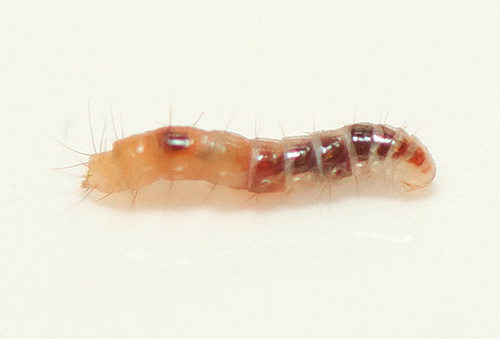
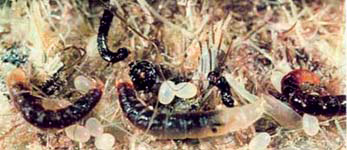
The main food of flea larvae is made up of various organic remains, down to rotting grass, and only in the nests of mammals and birds can they feed on the excrement of adult fleas, overflowed with undigested blood.
In general, to find flea larvae anywhere it is quite difficult. Certainly they will not be on the animal's fur: fleas usually lay their eggs outside the host's body. However, with a strong infection of flea eggs in dogs, they can also be found in wool: in this case, the insects simply do not have time to jump off the animal.
The photo below shows flea eggs:
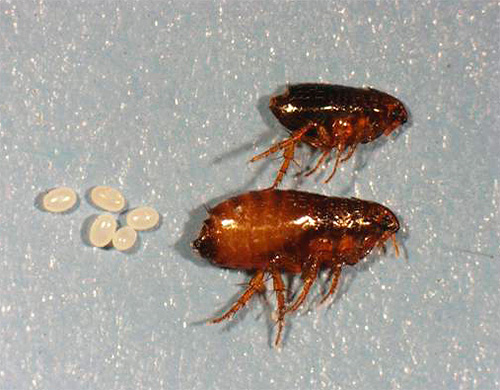

Each egg is less than a millimeter in length, and they are visually detected only with large quantities.
Adult insects are well distinguished from other parasites on dogs by their size: even a hungry young tick, and that one larger than an adult flea.In addition, no parasite on a dog can jump as far and high as fleas do.
The only insects with which fleas have some common external features are lice and lashing. However, no matter how small the lice are, fleas in dogs are well distinguished from them by their dark color (white lice) and by the fact that they are always found on the skin of the animal, but not on the hairs. Lice, however, spend their whole lives, just attached to the host's hair.
By the same sign, fleas are easily distinguished from lashing. In addition, neither lice nor lashes can not jump. And if the parasite sharply disappeared from sight, as if it was not here - that is exactly a flea.
Details on the lifestyle of fleas on dogs
Fleas do not really live on dogs for a long time. Here they only eat, spending most of their lives in dark, secluded places, of which they are very easy to get to the source of food.
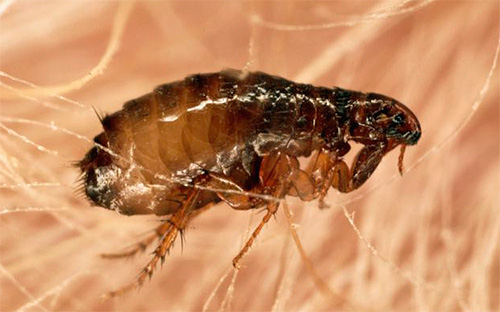
Most often between meals, parasites are in the booths and places where the dogs rest. Usually their eggs develop here and the larvae grow. And these places should be checked if there are symptoms of fleas in the dog.
Fleas breed quicklycan say avalanche.One female every few days literally sprinkles eggs around herself, pushing them out of her body under great pressure, thereby increasing the area of distribution of her offspring. Even if she does it right on the dog, most of the eggs will fall to the floor or the ground. Larvae will hatch from them, molt three times, pupate and turn into adult insects.
It is interesting
Under ideal conditions, a flea can live up to two years, given the three weeks of the larval stage. Usually, the life of the parasite is only a few weeks. An adult female, in principle, is able to lay up to 5,000 eggs in a lifetime.
Adult insects leave the dog’s body as soon as possible after feeding. They cannot move far and hide in the feather of a refuge - under a stone, in the grass, in the carpet. And where the flea dog ran, for sure the whole route will be littered with satiated parasites.
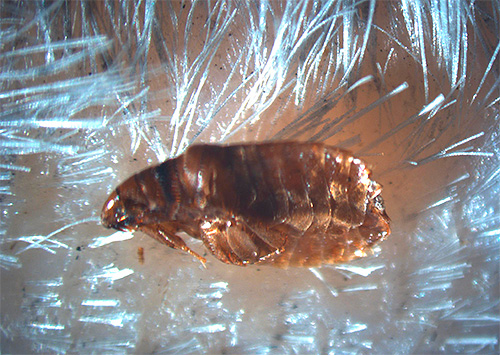
It is interesting
Fleas can recognize different levels of cortisol and corticosteroids in the dog's body. Accordingly, fleas in a pregnant dog “know” when it should be puffed up, and by this time they are especially actively interested in it, in order to subsequently move to puppies as a more favorable and safe food source.

It is not worth puzzling over the question of where fleas come from dogs - a pet can pick them up everywhere:
- when walking in the woods (there are a lot of fleas in the holes of wild animals)
- from another dog outside (either from a cat or a rat)
- from a person whose clothing parasites accidentally fall
- in any room infected with insects.
On a note
Very often dogs catch fleas, falling out in carrion. This instinct will not allow even the purest dog to pass by the "dummy". And all the parasites who waited patiently for the new mobile restaurant after the death of the old, with a frenzy will pounce on a new animal.
What are dangerous fleas for dogs?
Fleas on dogs are carriers of many dangerous diseases. For example, it is dog parasites that carry eggs of cucumber tapeworm, which grows up to 50 cm in length, and other worms.

The dogs themselves can become infected by eating parasites, and can infect humans by accident if a flea from a dog enters the human digestive tract.
At flea bites Can infect dogs with salmonellosis, brucellosis, plague and other deadly diseases. Compared to this, flea allergy in dogs, occurring in every fourth pet, does not seem to be so serious. However, in flea puppies can cause dangerous dermatitis and anemia.
It should be remembered that dog fleas are dangerous for a person to whom they can easily be transmitted.

At the same time, many diseases transmitted by parasites are deadly for humans. Among them are plague, anthrax and encephalitis. That is why finding bloodsuckers on your pet, you need to immediately decide how to cure a dog from fleas.
Symptoms of the presence of fleas on the dog
The main signs of the presence of fleas on a dog are as follows:
- animal itching, constant scratching and anxiety
- detection of flea excrement in dog hair in the form of dark small grains
- dog allergy
- and, of course, the direct detection of insects on the body of the pet.
Revealing in the dog's body of abundant helminthic invasions can also, to a certain extent, be a sign of infection of the animal with fleas.
Means ridding the dog of fleas and their use
Treatment of a dog for fleas consists in treating its hair with special means. It can be:
- flea sprays for dogs, mostly suitable only for adults and healthy animals and giving fast and reliable results. Hartz and Frontline flea sprays are widely known today and are very effective.
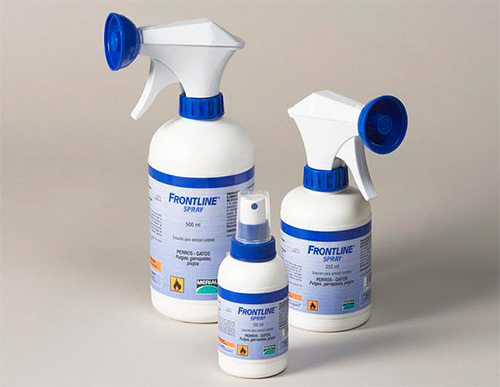
- Drops on the withers, allowing to treat a flea dog that is acutely responsive to aerosol means. The most popular among dog owners are Frontline, Stronghold and Advantage.

- Flea shampoos - perhaps the most benign option. Even puppies and especially sensitive animals can be bathed with them. Very famous shampoos for flea dogs are Beaphar, Mr. Bruno, Celandine.

- Flea and tick collars for dogs, considered particularly effective as a prophylactic.

From fleas to dogs can be recommended and folk remedies - decoctions of wormwood, lavender and tansy. To successfully combat parasites, such tools should be applied in strict accordance with the recipes.
When choosing how to treat a dog for fleas, it is necessary to take into account the individual characteristics of the animal. In the ideal case, the treatment of dogs from fleas and ticks should be carried out by means recommended by a veterinarian.
Prevention of dog infection with fleas
Given the great chances of a dog picking up parasites, flea prevention in dogs should be made constantly. There are several measures to protect the dog from fleas:
- minimize contact with stray animals.
- Regular treatment of dogs from fleas before the warm season with special drops or the use of an anti-flea collar.
- Cleaning the place where the dog rests - booths, sun beds, rugs. It should be done at least once a week.
- Regular brushing the dog with a fine comb.
Such measures will reliably protect the dog from fleas, even if it accidentally brings them from the street.
What can lead fleas in dogs: it is important to know every owner

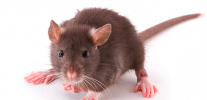
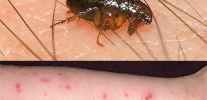

It is very important to protect your dog from fleas. Our Joey, we have a poodle, already 3 years old. I can say that during this time we have never had any fleas. And, the thing is, I regularly treat my dog for fleas - using drops on withers.
Hello, we use drops of a wide range of action, help not only from ticks, but also from fleas, mosquitoes, flies. We almost all summer-autumn live in the country, through the fence we have a forest, and all these parasites there Nemer, used to and spray, and collars, and somehow it was not. Then the vet advised us, and we listened and did not regret it, now at least there are no ticks, and the fleas are no longer seen at all. In the application of the drop is simple, we liked it, but only after processing for two days you cannot allow the dog to the children and be more careful yourself.
How many drops does a chihuash need to drop?
5-8, depending on the age and weight of the animal.
What kind of drops? I understand that in the house they still remain?
And my dog drops do not help. Right now I'm trying to fight a huge number of fleas, which she appeared a couple of weeks ago.
We have been fighting with fleas for 1.5 months now! Drops, collar, shampoo. Cucumber room processing, Deltsidom. The floor, the sofas, the bench were generally removed in the package. I even processed the staircase from the first to the second floor, and still find new and alive. I add turpentine when washing the floor, the parquet is old, the gap. It is impossible to wash the dog every other day. Scratched his entire back! She is already old, 13 years old. What else can you do?
I do not even know how to comb a spitz with a lush head of hair with a small comb. No, It is Immpossible!